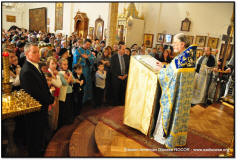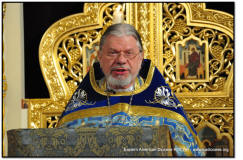December 16,
2011
New York: A Sermon by Archimandrite Ioann (Magramm) on the feast day
of the Icon of the Mother of God of the Sign
 "Come,
all ye nations, unto the temple of the Lord! Let us gather together
and hymn the all-praised Mother of our God, and let us fall down
with faith before her Icon, for she hath given now a deposit of
salvation unto the Russian land; therefore, radiantly celebrating
this feast, let us cry aloud unto the Theotokos: Rejoice, O ready
help unto the world, the rejoicing and salvation of our souls."
"Come,
all ye nations, unto the temple of the Lord! Let us gather together
and hymn the all-praised Mother of our God, and let us fall down
with faith before her Icon, for she hath given now a deposit of
salvation unto the Russian land; therefore, radiantly celebrating
this feast, let us cry aloud unto the Theotokos: Rejoice, O ready
help unto the world, the rejoicing and salvation of our souls."
Thus does the Russian Church call unto us on this feast day of the
Protectress of the Russian Diaspora – the wonderworking Kursk Root
Icon of the Mother of God of the Sign.
Our Synodal Cathedral also celebrates it patronal feast day today.
But it is not only the feast of our cathedral, but the feast of the
whole Orthodox Diaspora, and not only, but also the feast of our
homeland, the House of the Most Holy Theotokos, as our Russian
Orthodox people once loved to call their country.
For over 700 years the Kursk Icon has been performing countless
miracles, drying the tears of the sorrowful and needy, and healing
many souls.
In 1295, in the woods of the Kursk region, the wonderworking Icon of
the Sign appeared to one pious man, lying face down at the root of a
large tree. When he but lifted the icon off the ground, at once a
spring flowed fourth from the spot where it had lain.
Word of this quickly spread, and the Prince of Rylsk ordered that
the Icon be brought to the city, but the Icon constantly vanished
from the church by miraculous means, returning to the forest, to the
tree where it was found.
 The
people decided that the Mother of God had graced that spot, and
built a chapel, where they then left the Icon. A priest named
Bogolyub was assigned to the spot, where he lived permanently.
The faithful came to venerate the Icon, from which flowed countless
miracles.
The
people decided that the Mother of God had graced that spot, and
built a chapel, where they then left the Icon. A priest named
Bogolyub was assigned to the spot, where he lived permanently.
The faithful came to venerate the Icon, from which flowed countless
miracles.
In 1383, the Kursk region was laid to waste by the Tartars, who
burned the chapel, chopped the Icon in half, throwing one half in
the fire and the other half to the side, and took the priest
prisoner.
Some time later, emissaries of the Muscovite Tsar, riding past the
Tartar encampment, heard Russian singing to the Most Holy Theotokos
and, discovering the imprisoned priest, purchased his freedom.
Fr. Bogolyub returned to the previous spot; he found one half of the
Icon at the chapel, while the other he found off to the side; when
he put the two together, they miraculous reunited.
Over the course of the following centuries, the Icon was famous for
its many miracles. The Icon even protected against an explosion in
the Cathedral of the Sign in 1898.
The terrible year 1918 eventually came, and with it the rise to
power of the Soviets, who covered the Russian land in blood.
Arcchbishop Averky (Taushev) wrote, that revolution is a result of
many people abandoning their faith in the Church and their true
reverence of the Theotokos. Only through terrible sufferings could
the Russian people cleanse themselves of their terrible sin.
In 1920, Bishop Theophan of Kursk brought the Icon to Greece from
Russia, and later to Serbia.
In 1950, the Kursk Root Icon of the Sign arrived in the U.S. and was
kept safe under a specially built awning here in the Synodal
Cathedral.
 Archbishop
Averky maintained that the veneration of the Theotokos in Russian
was greater than that of other nations. The virtues of the Most Holy
Virgin are especially close and dear to the Russian heart.
Archbishop
Averky maintained that the veneration of the Theotokos in Russian
was greater than that of other nations. The virtues of the Most Holy
Virgin are especially close and dear to the Russian heart.
For her humility and obedience, her dedication to God’s will, the
Russian people revere her all the more tenderly and piously, and
she, in turn, revealed the Sign of her Intercession for the Russian
people.
Life was difficult for Russians in exile. A service was written for
the Kursk Icon here in the Church Abroad, a service that acutely
describes the sorrows and hopes of the Russian Orthodox people:
Come, all ye that labour and are heavy-laden,
Come, ye that cry
and mourn,
Come, ye that patiently suffer,
Come, ye needy and
infirm,
Fall down before the icon of the Most Pure Virgin
And
each receive according to his need.
For behold, the all-hymned
Theotokos gives generously unto all,
Healing to the sick,
Sweetest comfort to those who dwell in sorrows,
Forgiveness to
sinners and salvation to all who flee unto her with faith.
O Venerable Father Seraphim, who prayest unceasingly for the Russian
land,
Behold our sincere zeal,
Hear the prayer we offer up
before the icon of the Most Pure,
And call unto the Theotokos for
us,
That for thy sake she will accept our supplications.
And you and I must always be grateful to her for remaining with us
here, and if we will but turn to her with faith and hope, then she
will be merciful unto us. Amen.
Archimandrite Ioann (Magramm)
December
10, 2011
New York
See Also:
New
York City: Historic Joint Concelebration by Hierarchs of OCA & ROCOR
in the Synodal Cathedral of the Sign
Media
Office of the Eastern American Diocese


